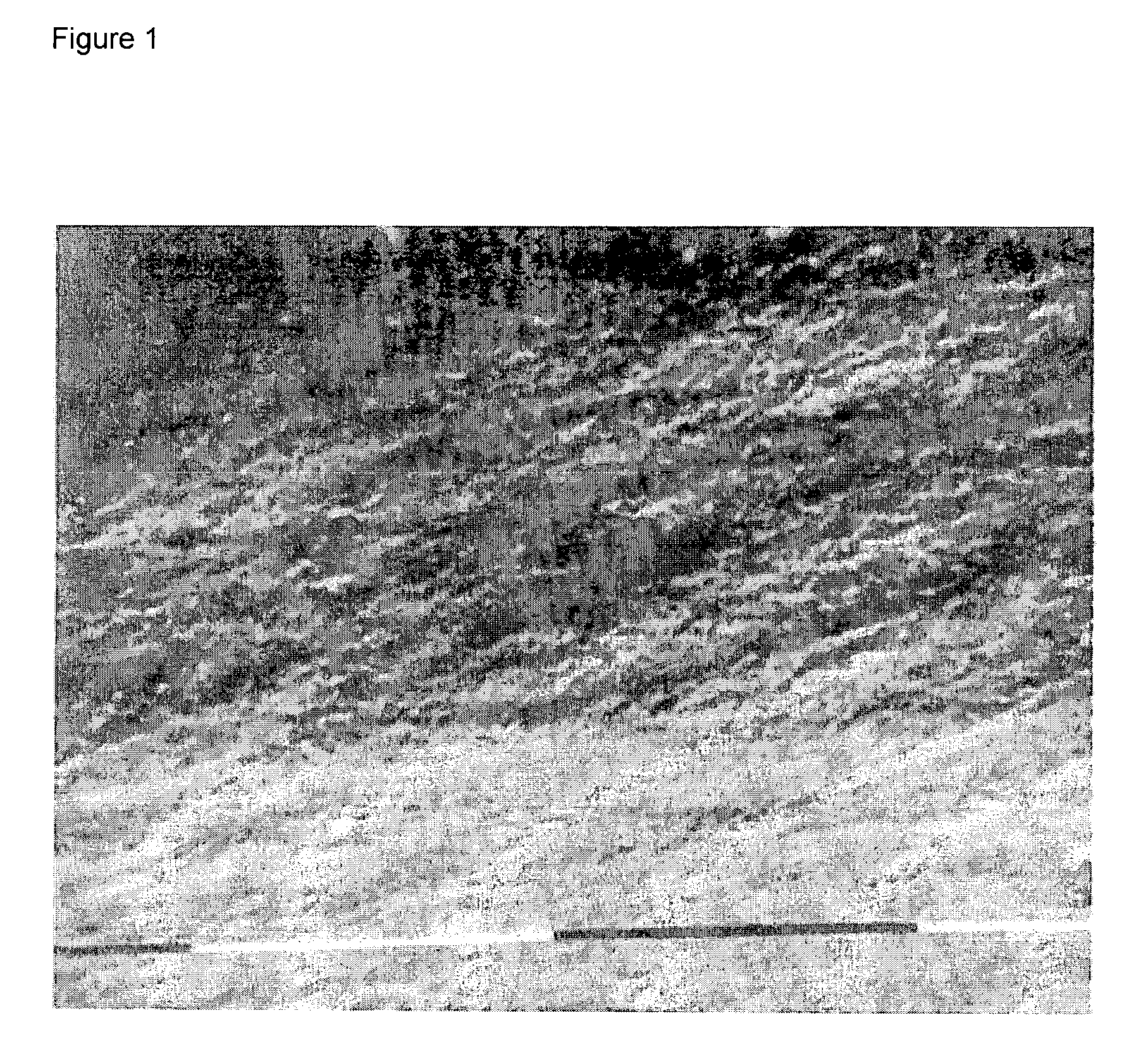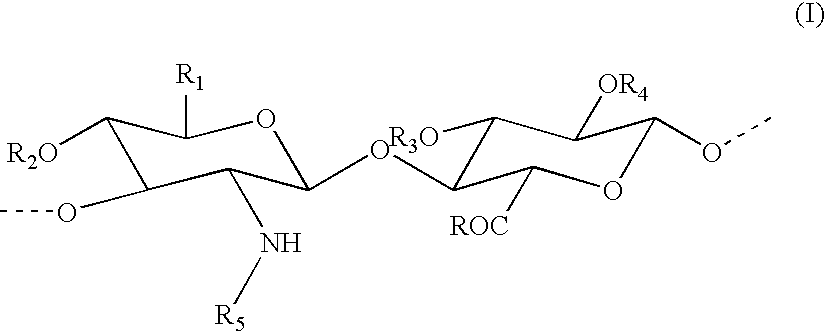Percarboxylated polysaccharides, and a process for their preparation
a technology of percarboxylated polysaccharides and polysaccharides, which is applied in the field of percarboxylated polysaccharides, can solve the problems of unpredictability and substantial degradation of polymers, and achieve the effects of reducing the number of oxidized polysaccharides
- Summary
- Abstract
- Description
- Claims
- Application Information
AI Technical Summary
Benefits of technology
Problems solved by technology
Method used
Image
Examples
example 1
Preparation of percarboxylated hyaluronic acid in the form of a sodium salt with 25% percarboxylation
[0065]1 g of sodium hyaluronate (2.5 mmole) with a mean molecular weight of 200 KDa is solubilised in 50 ml of water. The solution is cooled in a bath with a thermostat set at −1° C., and is then supplemented with 40 mg (0.26 mmole) of TEMPO and 260 mg (2.5 mmole) of NaBr (sodium bromide). A solution of 15% sodium hypochlorite is added in a quantity of 0.3 ml, equal to 0.625 mmole, corresponding to 25% of the moles of sodium hyaluronate present. The solution is mixed and the pH maintained at 9-9.2 by the addition of a solution of 0.5 M NaOH. Some minutes later, the pH remains stable with no further additions of this kind. A volume of absolute ethanol equal to 5 ml is added and the solution is neutralised by adding 1 M HCl until the pH reaches 6.9-7.2. Then 95 mg (2.5 mmoles) of sodium borohydride is added and the mixture is agitated overnight at room temperature. The solution is neut...
example 2
Preparation of percarboxylated hyaluronic acid in the form of a sodium salt with 50% percarboxylation
[0069]1 g of sodium hyaluronate (2.5 mmoles) with a mean molecular weight of 200 KDa is solubilised in 50 ml of water. The solution is cooled in a bath with a thermostat set at −1° C., and is then supplemented with 40 mg (0.26 mmole) of TEMPO and 260 mg (2.5 mmole) of NaBr (sodium bromide). A solution of 15% sodium hypochlorite is added in a quantity of 0.6 ml, equal to 1.25 mmole, corresponding to 50% of the moles of sodium hyaluronate present. The solution is mixed and the pH maintained at 9-9.2 by the addition of a solution of 0.1 M NaOH. Some minutes later, the pH remains stable with no further additions of this kind. A volume of absolute ethanol equal to 5 ml is added and the solution is neutralised by adding 1 M HCl until the pH reaches 6.9-7.2. Then 95 mg (2.5 mmoles) of sodium borohydride is added and the mixture is agitated overnight at room temperature.
[0070]The solution is...
example 3
Preparation of percarboxylated hyaluronic acid in the form of a sodium salt with 75% percarboxylation
[0074]1 g of sodium hyaluronate (2.5 mmoles) with a mean molecular weight of 200 KDa is solubilised in 50 ml of water. The solution is cooled in a bath with a thermostat set at −1° C., and is then supplemented with 40 mg (0.26 mmole) of TEMPO and 260 mg (2.5 mmole) of NaBr (sodium bromide). A solution of 15% sodium hypochlorite is added in a quantity of 0.9 ml, equal to 1.875 mmole, corresponding to 75% of the moles of sodium hyaluronate present. The solution is mixed and the pH maintained at 9-9.2 by the addition of a solution of 0.5 M NaOH. Some minutes later, the pH remains stable with no further additions of this kind. A volume of absolute ethanol equal to 5 ml is added and the solution is neutralised by adding 1 M HCl until the pH reaches 6.9-7.2. Then 95 mg (2.5 mmoles) of sodium borohydride is added and the mixture is agitated overnight at room temperature.
[0075]The solution i...
PUM
| Property | Measurement | Unit |
|---|---|---|
| molecular weight | aaaaa | aaaaa |
| molecular weight | aaaaa | aaaaa |
| temperature | aaaaa | aaaaa |
Abstract
Description
Claims
Application Information
 Login to View More
Login to View More - R&D
- Intellectual Property
- Life Sciences
- Materials
- Tech Scout
- Unparalleled Data Quality
- Higher Quality Content
- 60% Fewer Hallucinations
Browse by: Latest US Patents, China's latest patents, Technical Efficacy Thesaurus, Application Domain, Technology Topic, Popular Technical Reports.
© 2025 PatSnap. All rights reserved.Legal|Privacy policy|Modern Slavery Act Transparency Statement|Sitemap|About US| Contact US: help@patsnap.com



